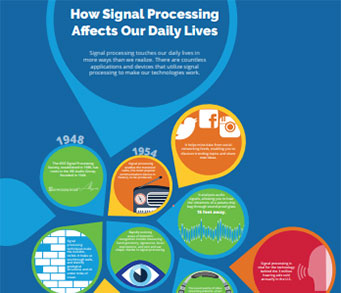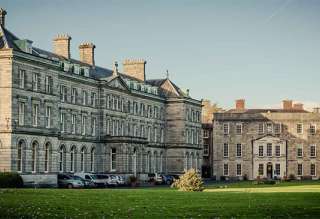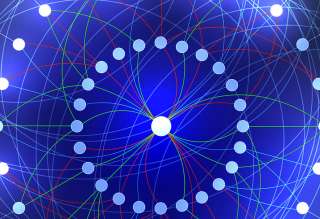SPS Feed
Top Reasons to Join SPS Today!
1. IEEE Signal Processing Magazine
2. Signal Processing Digital Library*
3. Inside Signal Processing Newsletter
4. SPS Resource Center
5. Career advancement & recognition
6. Discounts on conferences and publications
7. Professional networking
8. Communities for students, young professionals, and women
9. Volunteer opportunities
10. Coming soon! PDH/CEU credits
Click here to learn more.
The Latest News, Articles, and Events in Signal Processing
Situation-aware technologies enabled by multitarget tracking algorithms will create new services and applications in emerging fields such as autonomous navigation and maritime surveillance. The system models underlying multitarget tracking algorithms often involve unknown parameters that are potentially time-varying.
Standard interpolation techniques are implicitly based on the assumption that the signal lies on a single homogeneous domain. In contrast, many naturally occurring signals lie on an inhomogeneous domain, such as brain activity associated to different brain tissue. We propose an interpolation method that instead exploits prior information about domain inhomogeneity, characterized by different, potentially overlapping, subdomains.
We obtain a characterization of all wavelets leading to analytic wavelet transforms (WT). The characterization is obtained as a byproduct of the theoretical foundations of a new method for wavelet phase reconstruction from magnitude-only coefficients. The cornerstone of our analysis is an expression of the partial derivatives of the continuous WT, which results in phase-magnitude relationships similar to the short-time Fourier transform setting and valid for the generalized family of Cauchy wavelets.
The problem of locating signals transmitted in the proximity of an antenna array has been studied extensively in the signal processing literature. In this paper, we consider the standard array manifold models used in these works and show that they differ, sometimes significantly, from the model based on electromagnetic theory.

Ph.D. positions with full financial support are now available in Dr. Ying Liu’s group in the Department of Computer Science and Engineering at Santa Clara University (SCU). Dr. Liu is looking for self-motivated PhD students to work on image/video processing, machine learning and deep learning. Visiting scholars and students are also welcome.

Motivated by Shannon's channel coding theorem, error-correction coding has become an integral part of all modern communications systems and standards that have enabled the information revolution of the past decades. Recently, there has been a growing interest in mission-critical applications that have extremely stringent reliability and latency constraints, such as autonomous driving, industrial automation, and remote robotic surgeries.
September 4-6, 2019
Location: Dublin, Ireland
October 28-31, 2019
Location: Rome, Italy
Submission Deadline: July 15, 2019
Call for Proposals Document

The Chair of Theoretical Information Technology at the Technical University of Munich has an immediate opening for a
Doctoral student; Postdoctoral student:
Hardware Demonstrator for Post Shannon Communication (E13 TVL) (f/m/d)
A critical task of a radar receiver is data association, which assigns radar target detections to target filter tracks. Motivated by its importance, this paper introduces the problem of jointly designing multiple-input multiple-output (MIMO) radar transmit beam patterns and the corresponding data association schemes.
This paper reformulates adaptive filters (AFs) in the framework of geometric algebra (GA), developing a complete study of the resulting geometric-algebra adaptive filters (GAAFs). They are generated by formulating the underlying minimization problem (a deterministic cost function) from the perspective of GA, a comprehensive mathematical language well suited for the description of geometric transformations.
We exploit persymmetric structures to design a generalized likelihood ratio test for detecting subspace signals in homogeneous Gaussian clutter with unknown covariance matrix. The subspace model is employed to account for mismatches in the target steering vector. An exact but finite-sum expression for the probability of false alarm of the proposed detector is derived, which is verified using Monte Carlo simulations.
The robust adaptive beamforming design problem based on estimation of the signal-of-interest (SOI) steering vector is considered in the paper. The common criteria to find the best estimate of the steering vector are the beamformer output signal-to-noise-plus-interference ratio (SINR) and output power, while the constraints assume as little as possible prior inaccurate knowledge about the SOI, the propagation media, and the antenna array.
We consider the problem of jointly recovering the vector
In this paper, we address the problem of recovering point sources from two-dimensional low-pass measurements, which is known as the super-resolution problem. This is the fundamental concern of many applications such as electronic imaging, optics, microscopy, and line spectral estimations. We assume that the point sources are located in the square
In this paper, we bridge the problem of (provably) learning shallow neural networks with the well-studied problem of low-rank matrix estimation. In particular, we consider two-layer networks with quadratic activations, and focus on the under-parameterized regime where the number of neurons in the hidden layer is smaller than the dimension of the input.
Pages
SPS Social Media
- IEEE SPS Facebook Page https://www.facebook.com/ieeeSPS
- IEEE SPS X Page https://x.com/IEEEsps
- IEEE SPS Instagram Page https://www.instagram.com/ieeesps/?hl=en
- IEEE SPS LinkedIn Page https://www.linkedin.com/company/ieeesps/
- IEEE SPS YouTube Channel https://www.youtube.com/ieeeSPS












